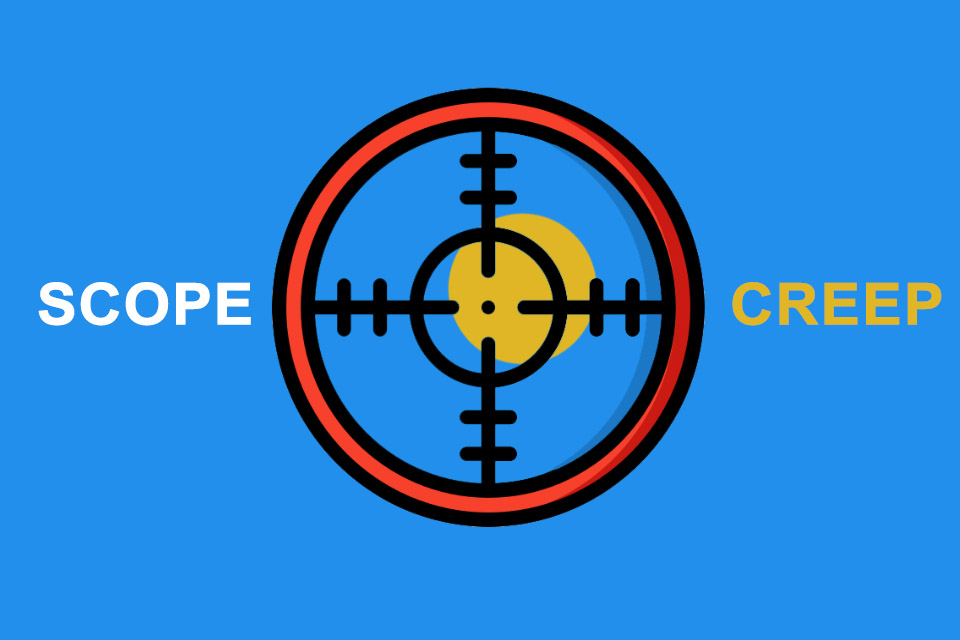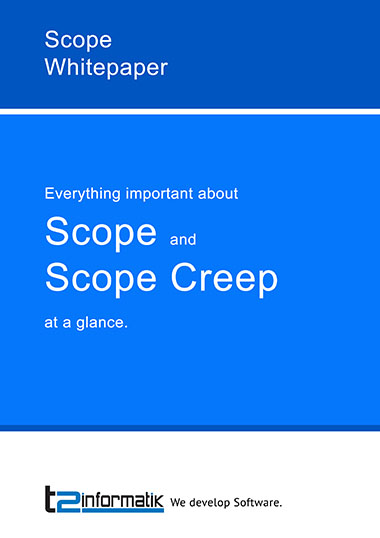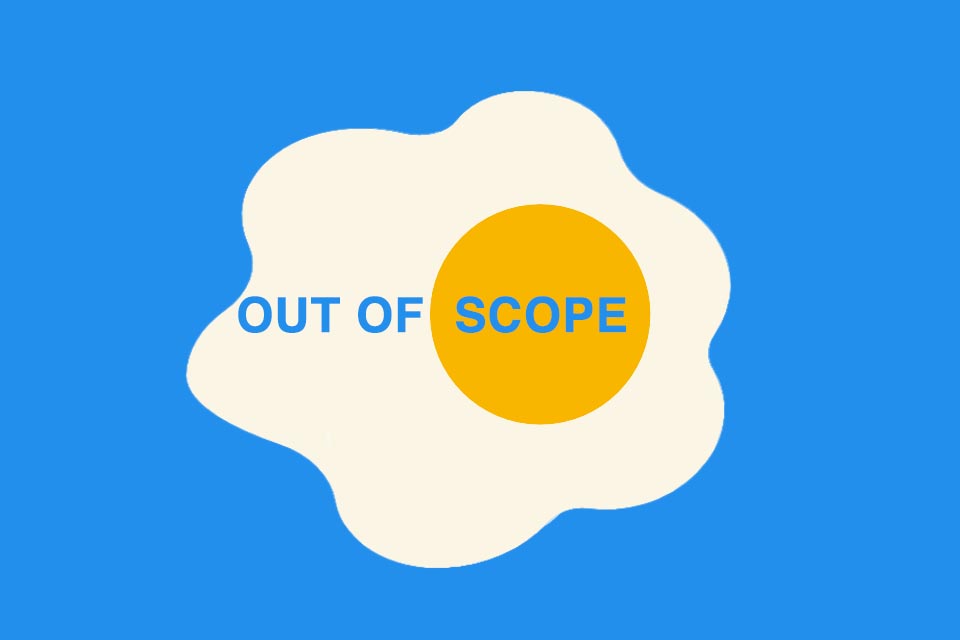What is a Scope Creep?
Table of Contents: Definition – Reasons – Consequences – Measures – Questions from the field – Download – Notes
Smartpedia: Scope creep refers to the extension or change of requirements or objectives of a project without adequate planning and control.
Scope Creep – the uncontrolled expansion of the project scope
“The work that needs to be done to deliver a product, service or outcome with the specified features and functions” is referred to as scope. [1] Scope creep, on the other hand, refers to the tendency to expand or change the requirements or objectives of a project beyond the original requirements and objectives without proper planning and control. [2] This often happens when stakeholders, project managers or team members are not clear about the objectives of the project and additional features, tasks or changes are added during the course of a project. Often this leads to delays, higher costs and lower overall quality of the deliverable.
To prevent scope creep, it is important to have a clearly defined project scope, clear project requirements and a plan for managing changes to project objectives.
Reasons for scope creep
There are various reasons why the scope of a project “creeps”:
- Inadequate definition of the project scope and unclear definition of goals almost inevitably lead to different views of what the project should achieve. In order to “please” as many participants as possible and resolve conflicting objectives, the realisation of requirements is summarily promised without thinking through the corresponding consequences. [3]
- If project requirements are not specified clearly and without contradictions, it is often unclear what is part of the project scope and what is not. In case of doubt, this leads to the realisation of wishes that were not originally agreed and planned for.
- By defining the system and system boundaries, companies create a common understanding for the development of a solution. There are two challenges in system context analysis: Not all information is available for assessment and there are no decisions on how information should be allocated. This easily leads to an expansion of the project scope without appropriate planning and control.
- If the business environment, the legal situation or the opinion of a customer changes, organisations seem to act ‘agilely’ by unceremoniously committing to the provision of new functions or features without calmly considering the implications in detail.
- Lack of transparency due to inadequate planning makes it more likely that scope will increase as there is no clear and shared understanding of project goals, timeline or budget.
- Poor communication between stakeholders, project or product managers and team members can lead to misunderstandings and changes in project scope.
- There is a dependency relationship between the client and contractors. If the client feels it has the upper hand, it can make demands on a project that jeopardise the schedule, effort and budget, but which are met by the contractor because of the importance of the project or the client.
- The refusal of stakeholders and team members to use an agreed change management process can also contribute to a creeping expansion of the project scope. [4]
Last but not least, “good will” can also contribute to scope creep, e.g. when a team member accepts requests communicated verbally or by email, but drastically underestimates the amount of work required to realise them.
What are the possible consequences of scope creep?
Scope creep can lead to the project requiring additional resources such as time, money and labour, which significantly increases the overall cost of the project. This has an impact on the schedule and, in business practice, often leads to delays in product completion.
When expanding the scope of the project leads to delays, higher costs and lower quality, the morale of team members often suffers, making it harder to keep the project on track. At the same time, delays – whoever is actually responsible for them in individual cases – often contribute to a loss of credibility for a company. This often affects customer satisfaction and the company’s reputation suffers as a result.
In order to cushion the possible consequences of scope creep, organisations in distress often withdraw staff from other projects. This means that they are missing elsewhere, which can lead to delays in other developments, further shifts in resources and more problems. This sets in motion a negative spiral that is difficult to stop.
What measures help against scope creep?
In addition to the shared responsibility of all stakeholders, there are various measures that companies can initiate against scope creep:
- The project scope should be defined before the project begins and agreed upon with all parties involved. As a service provider, for example, a clear clarification of the assignment is important, as this creates a clear understanding of what those involved expect in the course of the project or development. This ideally helps to avoid misunderstandings and more expensive rework.
- The project requirements should be clearly defined and accepted by all participants. In terms of professional requirements management, it is important to identify requirements that are correct, complete, unambiguous, free of contradictions, evaluated according to importance and/or stability, testable and traceable. This ensures that all stakeholders know what is and what is not part of the project scope.
- Using a project management methodology, defined process or common workflow can also help structure the project and reduce the risk of scope creep.
And certainly a dedicated change management process also helps. With this, organisations ensure that change requests are recorded, assessed, prioritised, realised, implemented and tested in a structured way.
Questions from the field
Here you will find some questions and answers from the field:
Who is responsible for scope creep?
One challenge in scope creep is that the increase in project scope is gradual and therefore difficult to perceive. To prevent this creeping change, different actors have to take responsibility:
The project manager, for example, is responsible for monitoring the project and ensuring that it stays on track. He or she should be aware of the potential for scope change and actively manage changes to the project scope.
Stakeholders, including customers, clients or end-users, play a crucial role in preventing the project scope from expanding. They need to clearly communicate their requirements and expectations for the project and work with the project manager to ensure that scope changes are properly managed.
Team members are also responsible for preventing scope creep by being clear about the project scope, raising concerns about changes that could impact the project, and actively participating in change management.
Ultimately, scope creep can only be avoided through clear communication between all stakeholders, coordinated working, regular feedback and a planned and controlled approach.
What is a scope leap?
Scope Leap refers to a sudden shift in the strategic focus or tactical direction of an organisation that completely changes the scope of the project. In contrast to scope creep, in which the project scope expands gradually, scope leap occurs abruptly and redefines the entire project. This change usually results from organisational decisions that respond to new market conditions, technological developments or changing customer requirements.
Obviously, a scope leap has a significant impact on a project. The sudden realignment of strategic focus often requires extensive rescheduling, leading to significant delays and cost increases as additional resources are needed to fulfil the new requirements. The drastic change also increases the risk of uncertainties and errors, as those involved have to adapt to new circumstances from one moment to the next. This often leads to confusion and frustration within the team, as previous efforts are devalued and the new goals remain relatively unclear. In extreme cases, scope leap can even lead to the project having to be cancelled or completely restarted if it is no longer feasible in its original form.
What is a scope grope?
Scope grope describes a situation in which the project scope remains vague or undefined, usually because the team has difficulty clearly formulating the requirements. In such cases, there is only a rough idea of the objectives, which leads to the project progressing without direction. This can have serious consequences and lead to projects becoming ‘scope drifters’, ‘productivity spoilers’ or ‘promise stealers’. [5]
Without clear goals, the project drifts along in an unstructured manner, leading to frequent changes of direction and inefficient use of resources. The project moves forward, but without a clear direction or prospect of success. This is referred to as ‘scope drifters’.
The unclear definition of the project scope impairs the productivity of the team. Without clear direction, team members often work on irrelevant tasks or with the wrong focus, resulting in wasted time and frustration. These are ‘productivity spoilers’.
An unclear project scope can also lead to unrealistic expectations or promises being made. However, these ‘promise stealers’ cannot be fulfilled as the exact requirements and objectives are not defined, which ultimately undermines stakeholder trust.
Scope creep therefore represents a considerable risk in project management, which significantly increases the risk of project failure. To avoid this, clear communication and a precise definition of project objectives are essential.
Why is scope creep also possible in agile projects?
Notes:
[1] The scope definition is taken from the PMBOK of the Project Management Institute (PMI).
[2] PMBOK defines scope creep as “when additional scope or requirements are accepted without adjusting the corresponding schedule, budget, or resource needs”.
[3] In many iterative projects, it is “normal” that new requirements are added to a backlog, for example. Scope creep only occurs when the scope of a project expands without adequate planning and control.
[4] Ideally, stakeholders should agree to use official communication channels and defined formats for exchange, such as sprint reviews. Even if this is subjectively a disadvantage compared to immediate and situational communication, practice often shows that adherence to processes combined with regular feedback leads to better results in the medium term.
[5] Preventing Scope Creep, Grope and Leap from Killing Your Projects
Here you can find a video about What is Scope Creep?
If you like the article or would like to discuss it, please feel free to share it in your network. And if you have any comments, please do not hesitate to send us a message.
Here you will find additional information from our Smartpedia section:




